The Perfect Pakistan Itinerary for 2 or 4 Weeks
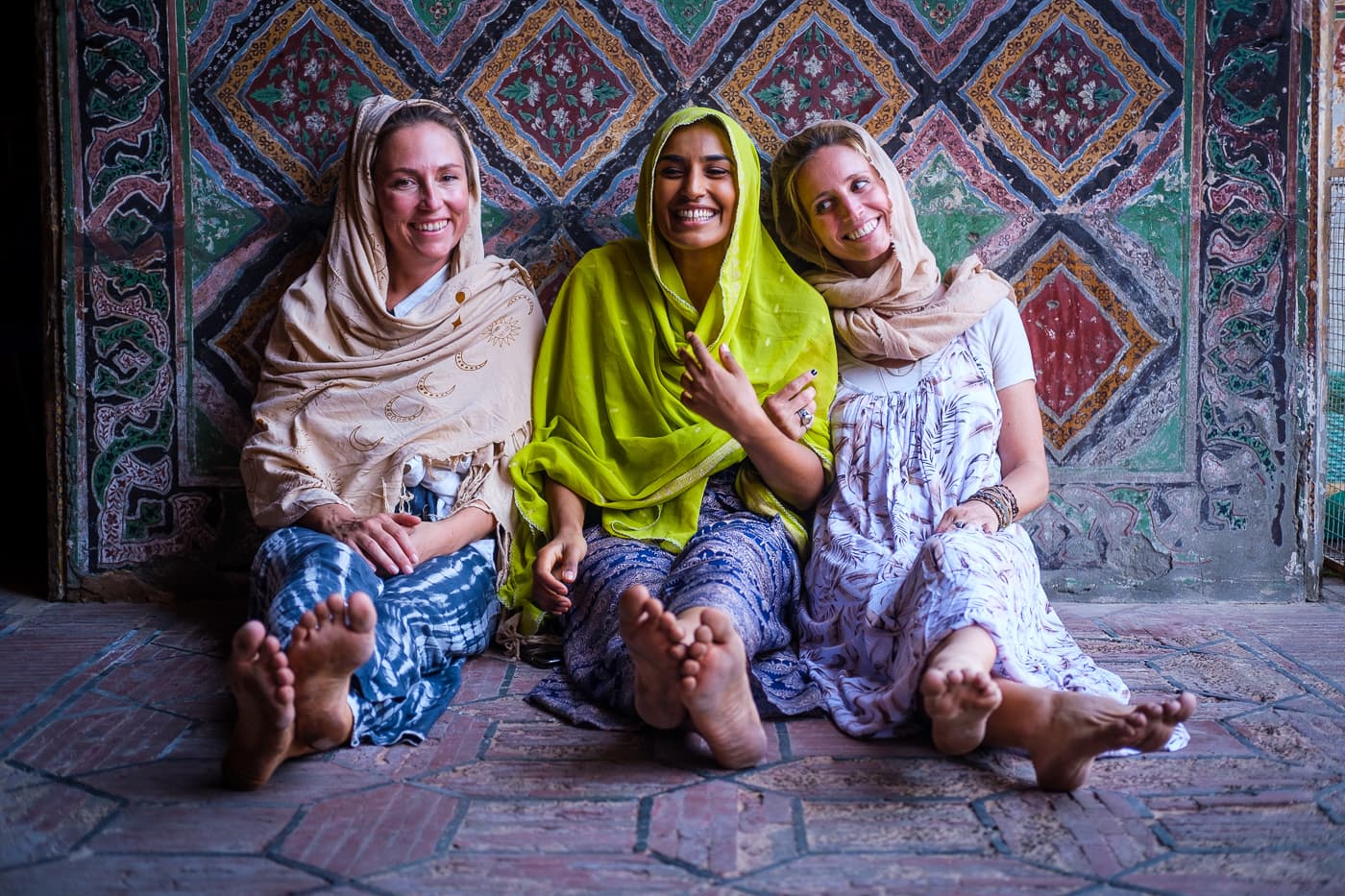
I’ve been to Pakistan more times than I count by now and intend and going back more in the future.
You see: there’s just so much to experience in Pakistan that, no matter how many times I go, I am always finding something new and exciting.
First-time visitors to Pakistan will have a lot to bite off for this reason. Where does one start and where does one venture in this vast and magnificent country?
That is precisely why I have gone ahead and crafted the most complete Pakistani travel itineraries possible in this post. Here, I share not only two potential routes for you to use – a 2-week and 4-week version – but have also laid out what you need to know and prepare beforehand.
Trust me everyone: I make itineraries and take people to Pakistan for a living. I have undertaken these exact itineraries myself multiple times and would will do them over again with pleasure.
Let’s go there now, shall we?
Why Visit Pakistan?
Pakistan is one of the last frontiers of adventure travel. Here you will find all of the hallmarks that make more established destinations, like Nepal, India, or Peru, so alluring: soaring mountains, welcoming locals, fascinating cultures, all this, and more. The fact that only a small fraction of tourists that would normally visit these places actually make it to Pakistan is an added bonus.
Relatively few people venture here for fear of being swept up by some terrorist insurgency or political coup, when, in reality, these events occur rarely in Pakistan. It’s safe to visit Pakistan, even for solo female travelers.
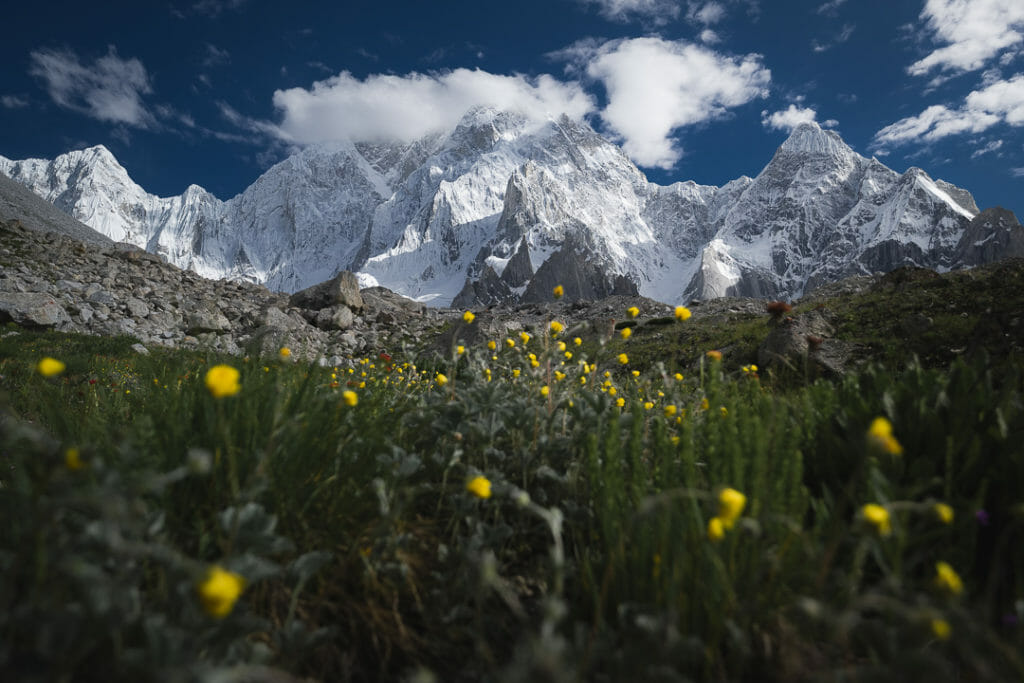
The “real” roadblocks are usually jumping through the bureaucratic hoops to get a visa. But if you’ve already visited the site, you know I cover these things in firey detail. (Refer to the Preparing for Your Trip section later for more on this.)
Everybody should consider traveling to Pakistan once in their lives. This is a truly spectacular country that has the power to change how you look at and choose to travel. It’s had a powerful effect on me and I think it will have a similar one on you.
So what’s an itinerary in Pakistan actually look like and what do you need to prepare? Well for one thing, no matter how long your itinerary might be, there will be lots of mountains for sure! That and tasty karahi.
Let’s talk shop and get into the details now. Below are some details to consider before heading out followed by a sample 2-week and 4-week itinerary in Pakistan.
When to Visit Pakistan
The “best time to visit” really depends on where you want to go and what to do in Pakistan. It’s a big country and has a lot of different climates, so it might be the case that you won’t be able to see and do everything in a single span of thirty days.
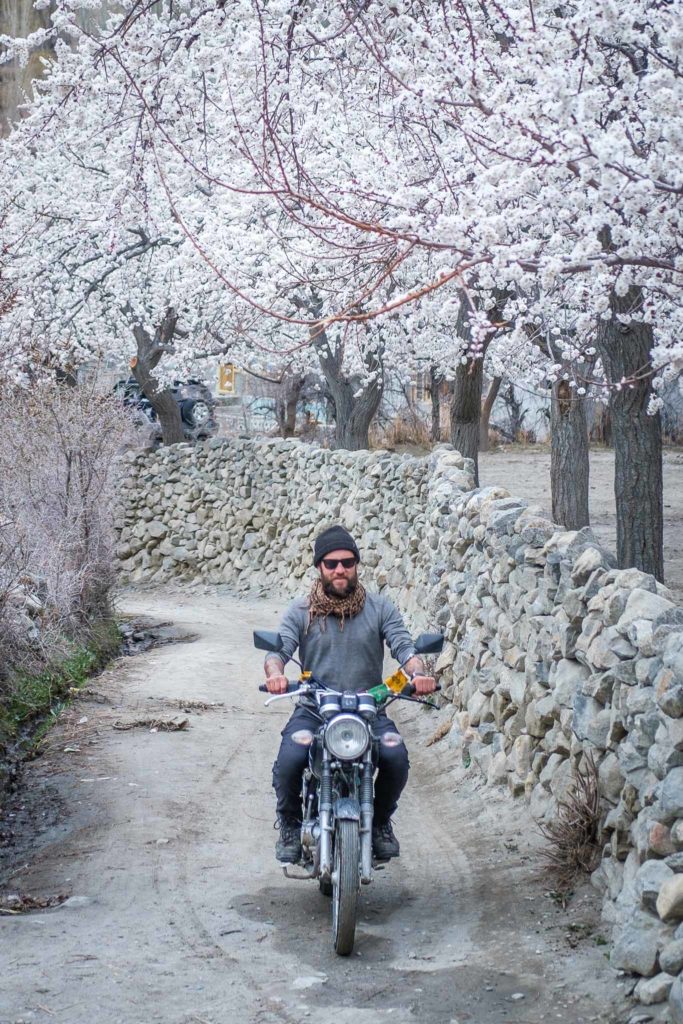
That being said, there are some months that are definitely better than others. Choose the right ones depending on what you want to accomplish with your travel itinerary for Pakistan.
- April-May (Spring): The north is erupting with cherry blossoms whilst the south is still comfortably warm. This is a great time to visit any part of the country. Trails and treks that cross over 4000 meters will most likely be impossible still as there will be a lot of snow remaining.
- June-August (Summer): The best and really only time to trek in Gilgit-Baltistan. That means K2, the Karakoram, glaciers, high passes, the works. The valleys will be quite hot though and the southern provinces will be in the midst of the hot, wet monsoon season. You’d be crazy to go to Balochistan or Sindh around this time.
- September-October (Autumn): Another colorful time for the north as the trees, particularly the poplars, turn a brilliant gold. Some trails may still even be open in Kashmir, KPK, and Gilgit-Baltistan (depending on the year). The south is starting to dry out but remains hot as hell.
- November-March (Winter): The northern areas are usually buried in snow and experience sub-zero temperatures. The south, on the other hand, is kicking into full swing. This is festival season in Lahore and beach season in Karachi. The Balochi coast and Makran Highway are very pleasant at this time.
I’d recommend visiting Pakistan on the edge of the shoulder months, particularly June or September. You can do a lot during these months and the prices should still be good.
Preparing for Your Trip
Consider the following before traveling to Pakistan:
- Visas – Pakistan’s strange and mercurial visa system can seem intimidating at times, but, in fact, it’s really not that bad. All you need to do is receive an LOI (letter of invitation) and then apply for an evisa on the NADRA website. You can acquire an LOI either through a local Pakistani tour company or by contacting Haris Ali Shah at +92 301 858 5054.
- Budget – The costs of your trip will vary WIDELY depending on what you want to do, how long you want to be there, and how you want to travel. To giv you an idea, a more shoestring 2-week itinerary in Pakistan will probably cost around $25-$30/day. That’s for a guesthouse, basic meals, and bus tickets. Prices go up from there.
- Packing – When visiting Pakistan, you’ll want to pack for every possible season. You’ll need warm clothing for when you’re in the higher, mountainous areas (even in summer) and light clothing for those hot days down in the valleys. A nice pair of rugged sandals in addition to your trekking boots also goes a long way. Try to wear long sleeves and pants as is customary in Muslim countries. For a complete packing list, refer to this article here.
- Safety and insurance – Despite a history of terrorism and rising tensions amongst its neighbors, Pakistan is a relatively safe country for tourists. Hospitality is second-to-none in Pakistan and the locals will go out of their way to make sure you’re ok. Still having a bit of insurance for the odd mishap still pays. I suggest investing in the best insurance for extreme adventure activities that I have ever found: Global Rescue.
For more information on what to prepare before starting your trip, be sure to read our backpacking Pakistan travel guide.
Getting Around Pakistan
Though Pakistan might appear to lack a transportation infrastructure at times, it’s still there – it just functions differently than what most travelers might be used to.
Here are your options:
2-week Pakistan Itinerary
With two weeks, you can see some of the best that Pakistan has to offer, including Hunza, Fairy Meadows, and Passu. You won’t have a ton of time to kill (you should ALWAYS be using your time wisely in Pakistan) but you shouldn’t be too rushed either.
Remember, Pakistan has a habit of throwing curveballs at you. Whilst this itinerary was planned with a little extra padding in case of delays, you never really know how bad those delays are going to be.
Come with an open mind and feel free to adjust the itinerary as needed.
For this particular itinerary, I recommend taking shared taxis as much as possible or having your own car. Do so, and the odds are better that you will get to see and do everything you want.
Refer below for a map of the 2-week Pakistan itinerary:
Day 1: Islamabad and Rawalpindi
Islamabad is the most convenient place to start your Pakistan itinerary as it is the closest major city to the mountainous north and is well connected with the rest of the country.
Islamabad is a planned city and totally different than any other metropolitan area in the country. It is orderly, well-planned, developed, and relatively clean. It can also be boring at times as it lacks the dynamism that other Pakistan cities, like Lahore and Peshawar, have in abundance.
There are some interesting things to do in Islamabad still. The Faisal Mosque and Pakistan Monument are nice to see – just be prepared for lots of selfies with the locals.
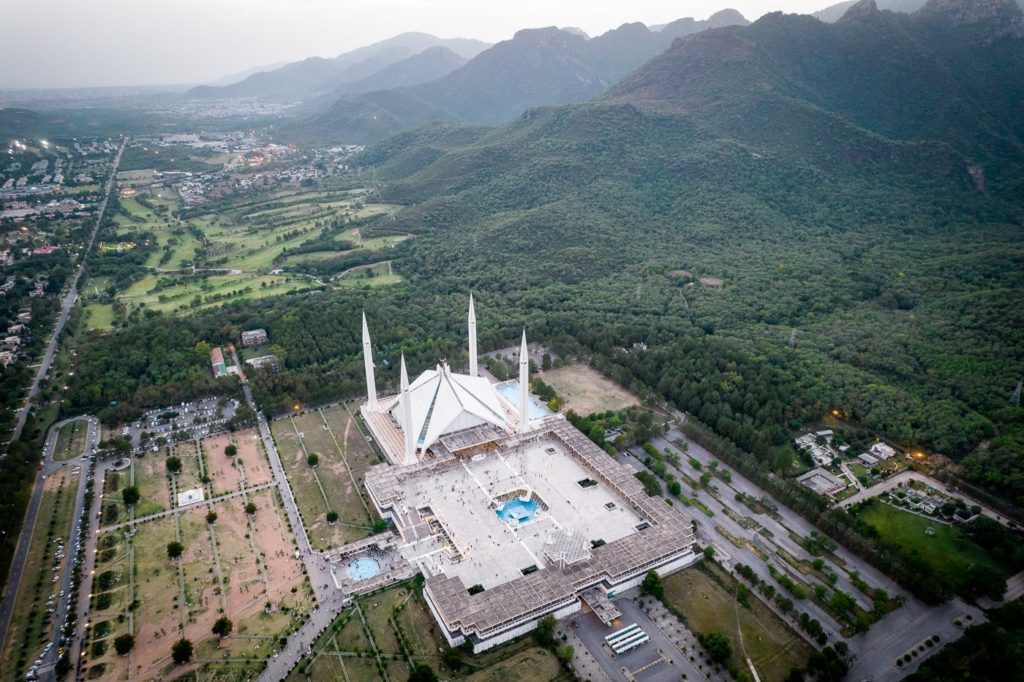
I suggest spending your first day shopping for your trip up north and sampling some local cuisine. The food scene in Islamabad is pretty solid and probably the most eclectic in the country. Despite its diversity though, the local Patan joints, like Kabul Restaurant, are the real winners.
Islamabad also has a lot of modern malls that could put American ones to shame, but the real place to shop is in Rawalpindi. The Raja Bazaar is one of the finest and most crazy and diverse markets in all of Pakistan.
Make sure you have Uber or Careem installed on your phone. These apps are the best way to arrange taxis in Islamabad and other major Pakistani cities.
The best place to stay: Grand Islamabad Hotel
See more places to stay in Islamabad here.
Day 2: Babusar Top
For this leg of the itinerary, I HIGHLY recommend taking a shared taxi or some other form of private transport. This is already going to be a very long day and it would be a shame if you wasted precious time by taking the much longer and uncomfortable bus.
Going private crucially means that you can travel via the Kaghan Valley and Babusar Top. This route is much more scenic in my opinion and resembles the foothills of Nepal in a lot of ways. The terraces cut into the valley walls are really impressive.
Total travel time to Raikot Bridge is 14-16 hours. Don’t bother stopping in Naran unless it’s for a quick tea or bathroom break. If it’s getting late and you still haven’t crossed Babusar, consider sleeping in or near Jalkhand if the driver allows it. Wake up early the next morning and drive the remaining 4 hours to Raikot Bridge.
Note though that Babusar Top is only viable from May-October when the pass is clear of snow. If the pass is not open, you will need to travel via the KKH and Chilas, which is also the route the NATCO bus takes. This option is closer to 16-18 hours long and there is no guarantee that you will make it to Raikot Bridge in time to get a good night’s sleep.

Best place to stay: Raikot Gazebo (Raikot Bridge) or Andaz Hotel (Jalkhand)
Day 3-4: Fairy Meadows and Nanga Parbat
Plan to be at Raikot Bridge between 11:00-12:00 on the third day of your 2-week Pakistan itinerary.
Once you arrive, immediately arrange for a jeep up to Fairy Meadows. Jeeps hold 4-5 passengers and cost 8000 rupees in total. These jeeps are expensive but, unfortunately, there is no other way to arrive at Fairy Meadows.
Refer to the Complete Fairy Meadows Guide for more advice on arranging jeeps and what to expect.
Consider grabbing some biryani to-go before leaving on the jeep. Fair warning: you may want to wait until after you finish the jeep ride to eat…

Once you’ve finished the jeep ride, walk an additional 2-3 hours, gaining 600 meters of altitude before reaching Fairy Meadows itself. Welcome to one of the most spectacular places in Pakistan! Looming above is the mighty 8,100 meter-high Nanga Parbat in all its glory.
Spend day 3 chilling and the next hiking up to Nanga Parbat Base Camp on the following. The hike takes 6-8 hours.
Top off your stay with a roaring bonfire and dance parties with Punjabis at the guesthouse.
Best place to stay: Greenland Guesthouse (Fairy Meadows)
Day 5-6: Karimibad and Aliabad
You’ll have to wake up early on day 5 and walk back down to jeeps to catch a ride. Aim to be back at Raikot Bridge before lunchtime.
Once you’ve arrived at Raikot Bridge, you’ll need to arrange transport to Gilgit. You’re better off taking a taxi since who knows when the next bus passes by. The price to Gilgit should be around 1000 rupee.
It should be noted too that at this point, you will be driving on the Karakoram Highway proper.
Once you arrive in Gilgit, you don’t need to stick around. Just arrange for another transport to take you directly to Hunza. Head in the direction of Karimibad – it takes 3-4 hours to arrive from Gilgit depending on your mode of transport.
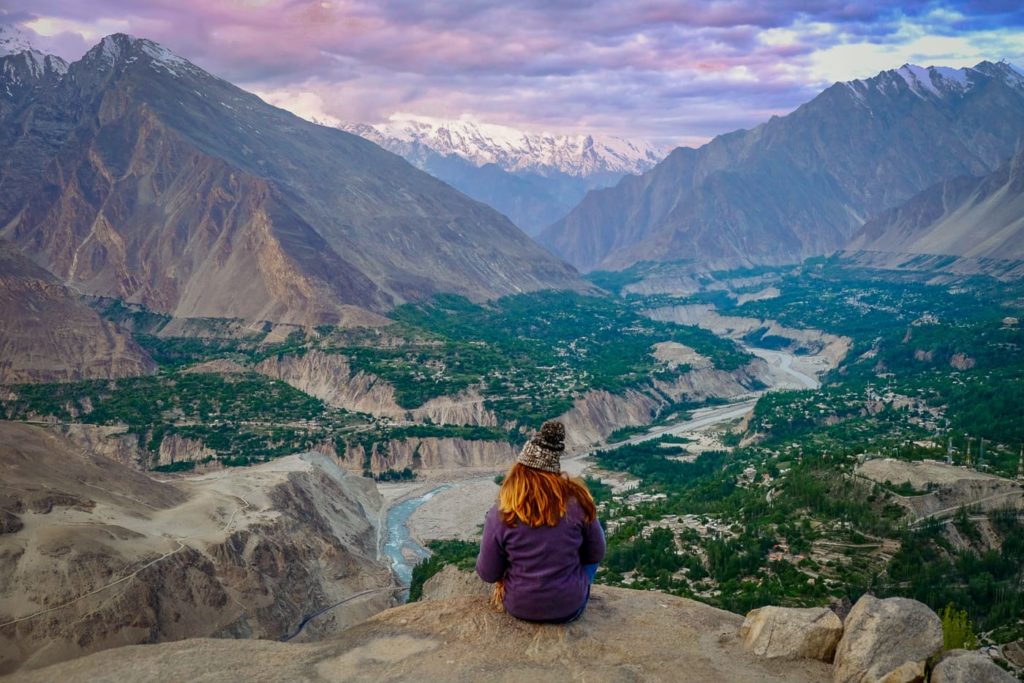
Rather than staying in Karimibad, which is a bit touristy, I recommend staying outside the town. There’s a fantastic guesthouse in neighboring Aliabad called Mountain Story and it is arguably one of the best in Pakistan.
Spend Day 6 exploring Karimibad. Altit Fort and Baltit Fort are the two most popular attractions. Be on the lookout for the man with the most epic beard in Pakistan at the former!
Finish your day by watching the sunset at Eagle’s Nest. This famous viewpoint features panoramic views of the Hunza Valley and the surrounding peaks, including Spantik, Rakaposhi, Ultar, and the infamous Ladyfinger Peak. Arrange for a taxi to take you up there and have it stick around until you’re done. You’ll only need an hour or so there.
Best place to stay: Mountain Story (Aliabad)
Day 7-11: Upper Hunza
Depart from Aliabad/Karimibad heading north on the KKH. Be on the lookout for the ancient petroglyphs on the side of the road just outside of town.
On the way to Passu, you’ll be passing by the stunning yet tragic Attabad Lake. This is a good place to stop for a quick break or jet ski (yes, there are jet skis here). Skip the boat ride as it’s pretty touristy and overrated.
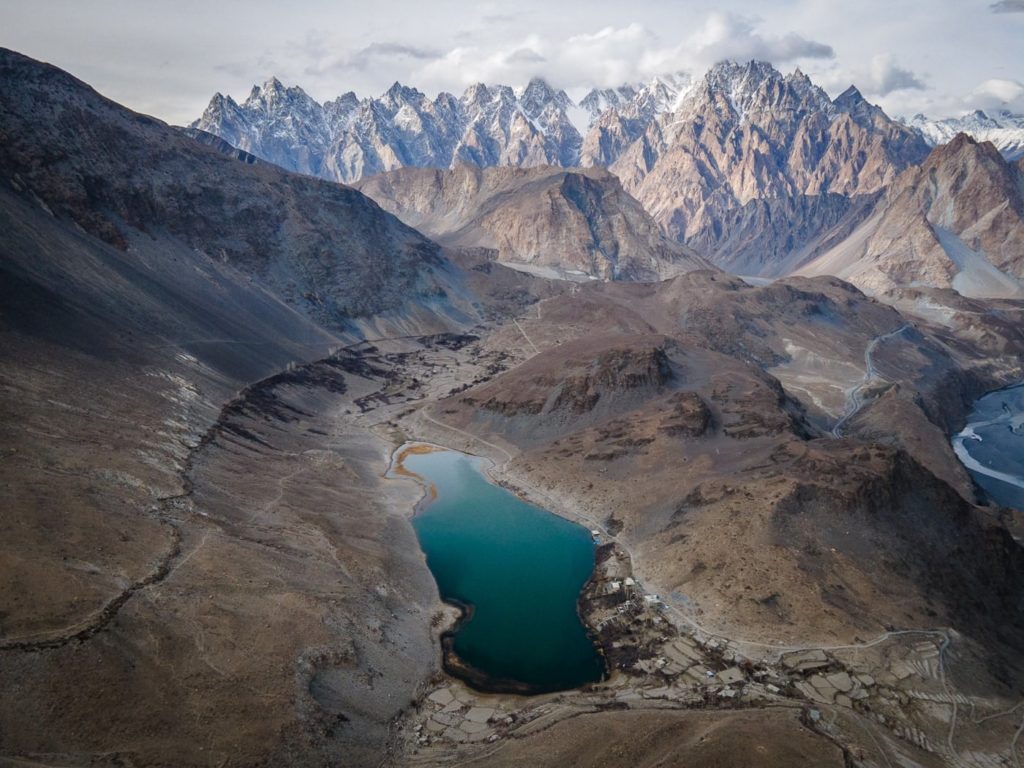
Beyond Attabad Lake, you will enter Upper Hunza, which is composed of several small communities. Each should have a handful of tourist hotels and guesthouses. Pick one that seems suitable to you and base yourself there for the next 4-5 days. Don’t bother looking for anything north of Sost.
There is a host of things to do around Upper Hunza (see next section). I’d recommend spending 1-2 days chilling with only a few activities planned and then dedicating the other 3 days to real adventuring. In particular, Patundas, Shimshal, and the Passu Cones shouldn’t be missed.
Best place to stay: Roomy Yurts, Gulmit – +92 311 1444100

Things to Do in Upper Hunza
Try to knock as many of these as possible whilst staying in Upper Hunza:
- Passu Suspension Bridge (1-2 hours) – Often labeled as the world’s scariest bridge. It’s made out mostly out of wood and is rickety as hell. Cross at your own risk!
- Passu Cones (1-2 hours) –Some of the most surreal mountains you’ll ever see. These look like a Hudson River School painting on acid. You can wtiness the cones from many places though the stretch of road between the Welcome to Passu sign and Batura Glacier viewpoint offers the best IMO.
- Borith Lake (2-3 hours) – A saline lake located near the terminus of the Ghulkin Glacier. Beautiful green colors and a great place to have a picnic.
- Ghulkin Village (half-day) – Just walk around and observe village life. The locals, who belong to the Ismaili faith, are very welcoming.
- Khunjerab Pass (full-day) – This is a long but doable day trip from Passu. Drive up to the Pak-China border, which is also the world’s highest crossing at 4,800 meters. Keep an eye out for ibex on the way up whilst driving in the Khunjerab National Park.
- Shimshal Valley (full-day) – A very rugged and at times desolate valley adjacent to Hunza. Features some of the most accessible 6000+ meter peaks in Pakistan. The road up the valley is rough but epic. Consider overnighting in Shimshal village.
- Patundas (3 days/2 nights) – This is one of the best short, multi-day hikes in Pakistan and features epic views of the Passu Cones, the Batura Glacier, and Shishpar. Enjoy the outdoor toilet and shitscape up there!
Day 12: Return to Gilgit
Since you’ll be catching an early flight the next day, you’ll want to return to Gilgit and spend the night there.
Depart from Upper Hunza at your leisure. It should be a 5-6 hour drive back to Gilgit.

Once you arrive, check into your hotel and take a load off.
There isn’t a ton to do in Gilgit but if you have some time to kill, go on a mission to find the Old British Graveyard. Several explorers for the era popularly known as “The Great Game” are buried here including the legendary George W. Hayward. To enter, you’ll need to find and ask the caretaker to let you in. Last I checked, he lives across from the cemetery.
Best place to stay: Hotel Grand Continental
Day 13: Return to Islamabad
If all goes well and the flights between Gilgit-Islamabad run on time, you should be back in the capital by early afternoon.
Make sure you bring a camera on the plane and try to request a window seat on the lefthand side of the plane. You’ll be treated to a face-to-face encounter with Nanga Parbat.
Settle into your hotel and reflect upon the epic two weeks you just spent in Pakistan. Order some room service, take a long nap, and then consider making the journey up to Monal in the Margalla Hills for dinner with a view. Dining up here is the best way to end any itinerary in Pakistan.
4-week Pakistan Itinerary
Day 1-12: Gilgit-Baltistan
The first half of our 4-week Pakistan itinerary should look exactly like the first twelve days of the 2-week version. Refer to the earlier outline and review what these days look like.
See more places to stay in Gilgit here
Day 13-16: Ghizar and Phander
Ghizar, Phander, and the surrounding valleys are best known for their stunning views, lakes, and general off-the-beaten-path appeal. There is not a ton of bucket-listy things to do in Ghizar.

There are some cool hikes to enjoy in the area. I recommend asking around in town or at your hotel for a guide who can show you some of the shepherd tracks the area has to offer.
Best place to stay: Lake Inn Phander: Contact: 03555203015, 03555203532, [email protected]
Day 17-18: Shandur Pass
If you are coming from the Gilgit side, the best way to access Chitral and this side of KPK is via the legendary Shandur Pass. Although this route is not accessible for parts of the year due to heavy snowpack, the route in the summer is one of the most beautiful roads you can drive in Pakistan.
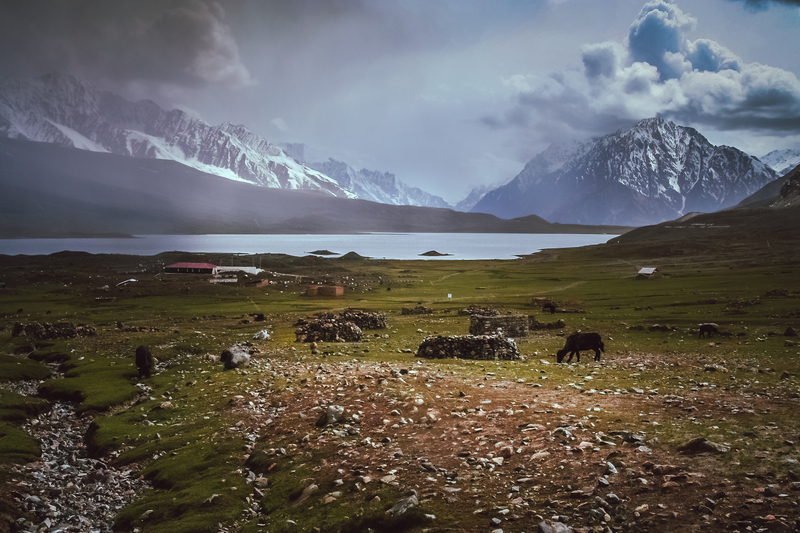
Shadur is also home to one of the world’s highest polo grounds. If you time your visit right, visiting the Shandur Polo Festival is an absolute must.
Best place to stay: I don’t really recommend staying at Shandur Pass since there are not really hotels in this area. Camping is an option if it is not too cold.
Day 19-21: Chitral
Chitral town is the biggest city in the area and a good launching point for upper Chitral and the Broghil Valley as well as for the Kalash Valleys. There are numerous hotels along the river which offer a relaxing atmosphere in stark contrast to the bustling and dirty bazaar.
The Chitral Fort is not the most impressive fort in Pakistan by any means, but still warrants a visit for an hour or so. As does the mosque shown below!

Chitral town is the place to stock up on supplies or just rest in between long drives or treks. Also, it is one of the few places in the area where wifi works so take advantage of it while you are here.
Best place to stay: Pamir Riverside Inn Hotel – +92 345 4384541
Day 22-23: Kalash Valley

Frankly, if you have time I recommend spending more like 4-7 days exploring Kalash. There is nowhere else in Pakistan like it.
The Kalashi people are unique to this one corner of the world; they have awesome traditional dress, speak a language unrelated to all other languages, AND they make their own wine.
There are even a handful of hikes to do in the hills around the valleys in the summer. I spent the most time in Rumboor, but there are two other areas to explore, Bumbaret and Birir.
It is hard to get the timing right but if you are in Pakistan for one of the Kalash winter or spring festivals, I highly recommend going!
Best place to stay: Engineer Khan Kalash Home Guest House – +92 345 5819188 (The Engineer’s son’s Whatsapp #)
Day 24-25: Kalam Valley
Located at the far end of Swat Valley – Kalam is a slice of paradise tucked away in a conservative corner of Pakistan.
Kalam Valley is forested, green, and more accessible these days thanks to a freshly sealed road leading into the valley.

I visited Kalam in April but still found I was able to do a great hike to one of the lakes in the area (Kandol). There are many single and multiday treks to do in the area if you have more time including more epic alpine lake treks.
For a trekking guide in the area with fair prices, contact Aslam at +92 313 9473399 (Whatsapp).
Best place to stay: If you have the extra budget, stay at Walnut Heights – +92 310 4702222
Day 26-27: Swat
Swat has endured a pretty crazy history over the last 15 years. Up until 2009, the Taliban controlled parts of Swat. It took several engagements from the Pakistani Army to finally get them out. Nowadays though, Swat is peaceful and free from Taliban rule. It is 100% safe to visit and there are many cool cultural spots (like old Buddhist sites) to check out along with the stunning natural landscapes.

Most people (myself included) base from Mingora and do day trips in the surrounding area before heading further up the valley to Kalam.
Best place to stay: Swat Valley Backpackers. Pameer Hotel in Mingora is a good option if you are looking for a hotel.
Day 28-29: Peshawar
The perfect Pakistani city to visit for just two days in Peshawar. Being one of the oldest cities in all of South Asia – Peshawar is rich in history, culture, food, and architecture.
Spending an afternoon roaming around the tea and kebab stalls of the old city while you take in the small details of old Haveli’s, gorgeous mosques, and bustling markets gets you a well-rounded view of the vibe of Peshawar.
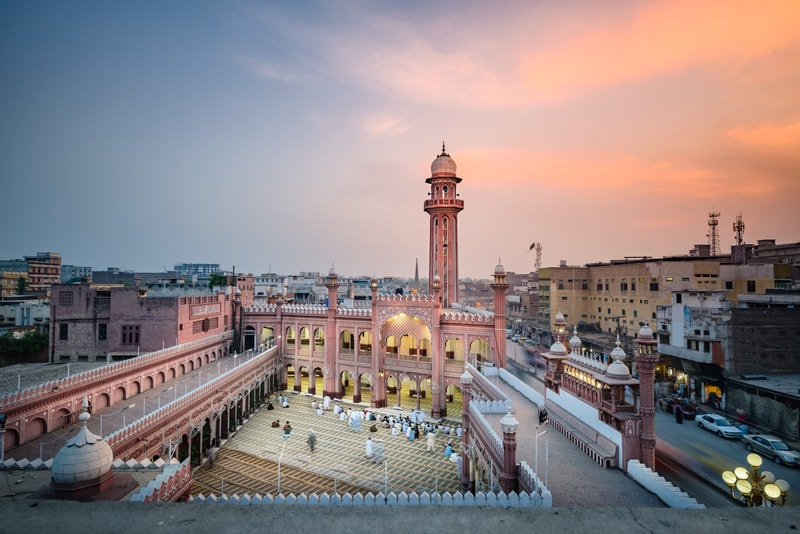
The local people I’ve encountered have been super friendly as well and keen to help show foreign visitors around.
Best place to stay: Pearl Continental Hotel, Peshawar – +92 91 111 505 505
Day 30: Return to Islamabad
Depart from Peshawar towards Islamabad. Journey time is 2-3 hours on very comfortable tarmac.
Once you’ve arrived in Islamabad, follow the outline for day 13 of the 2-week Pakistan itinerary.
Alternative idea!
Spend the entire month trekking in one of the most amazing places on earth: Concordia, home to the magnificent K2. A typical itinerary for the trek up to K2 Base Camp lasts around 21 days. If you intend on visiting Pakistan for 30 days, you can complete the trek and have plenty of time to see some other places. Lahore, Peshawar, the Swat Valley, and Fairy Meadows would all be excellent additions to K2.
Have even MORE time in Pakistan?
I don’t blame you for wanting to stick around! Here are a couple of ideas for how to extend your time in Pakistan beyond two or four weeks:
Lahore (2-3 days)
Whilst it hurts me a bit that Lahore is not featured in any of the above Pakistani itineraries, there is just too much to see and do in the north. And Lahore shouldn’t be rushed through for that matter either.
Lahore is considered the cultural capital of Pakistan and hosts some of its most hallowed landmarks, such as Lahore Fort, Badshahi Mosque, and the Shalimar Gardens. It is a sprawling, chaotic city, full of life and bereft of dull moments. Anyone who has traveled around India already will feel right at home in Lahore.

Also worth checking out is the infamous Wagah Border ceremony. Every day before sunset, the guards from the Pakistani and Indian sides come together in a friendly competition to see who has the best choreography. Get ready for a lot of high kicks, heel clicks, and shouts from flag-waving attendees as they cheer on their respective sides.
End your stay by having dinner at Haveli overlooking the Badshahi Mosque. Be there before sunset so you can hear one of the most incredible, goosebump-inducing calls to prayer of your entire life.
Best place to stay: Tourist Inn Hotel
See more places to stay in Lahore here.
Astore District (4-6 days)
The Astore Valley is more than just a landbridge between the KKH and Skardu – it also features some of the best high alpine scenery in the country.
From the Karakoram Highway, the journey starts by driving up the bleak and perilous mountain road leading to the heart of the district. Arriving in the oasis-like town of Astore, the landscape becomes quite green. In the hills above the town are carved, lush cultivated terraces filled with apricot, cherry, and other fruit trees.

From Astore, there are many options. Above the village is Rama Lake, a very picturesque alpine lake that is among the most visited places in Gilgit-Baltistan. You can also embark on a 4-day trek to the real Nanga Parbat Base Camp, Herligkoffer BC, via the Rupal Valley.
But Astore’s real highlight is the soaring Deosai Plains. At 4200-meters high, they are the second-highest alpine plateau in the world – after the Tibetan – and visiting should be a must on any itinerary in Pakistan. In the summer, they are blanketed with wildflowers of almost every shade. Most people visit via Jeep but it is possible to take a minibus from Astore to Skardu across the plains.
Skardu (6-8 days)
Skardu serves as the base for many of the most famous hikes in Pakistan, including Snow Lake and the K2 Base Camp Trek. These are multi-week expeditions that will most likely fill up your entire itinerary, but that being said, there is still PLENTY more to do in the area. The
Skardu itself is the largest city in Baltistan and isn’t much else besides an old fort (Kharpocho) and a few dusty bazaars strung together.

The area surrounding Skardu is much more impressive. The Katpana and Safaranga Deserts are some of the highest in the world. In the nearby mountains, the newly minted Marsur Rock hike provides breathtaking panoramic views of the Indus Valley. If you fancy a road trip, the scenery between Kachura and Basho Valley is excellent and very accessible.
Hikers can also take part in a number of shorter treks near Skardu. The neighboring Ghanche District features the best of the bunch, including Barah Broq, Makalu La, Thally La, and the Nangma Valley. None of these require any sort of special permits either.
So even if you don’t want to spend two weeks straight on glacier, there are good reasons to visit Skardu.
Best place to stay: The Garden Villa – Skardu +92 333 5915957
See more places to stay in Skardu here.
Wrap Up: The Ultimate Pakistan Itinerary
Pakistan is just one of those countries where you’ll never be able to do it all in one trip. This Pakistan itinerary just scratches the surface of what there is to do here. In a 30 day itinerary, I did not have the time to cover the south or parts of Balochistan either… save those ones for next time!
My biggest advice when planning out your own Pakistan itinerary is to focus on what you like to do and mix and match the above suggestions according to what you want to see and do. Like trekking? Head to the Skardu region. Want to dive deep into the culture? Go to a homestay and definitely visit the Kalash Valley! Cities your thing? Don’t miss Lahore – Peshawar – and Rawalpindi.

Love a place you visited in Pakistan? Mention it in the comments below so we can share the info with other travelers. Cheers guys!




Hi Chris. I’m currently planning my first trip to Pakistan and as a solo female I usually use travel books besides the net, but couldn’t find much out there. Thanks heaps for this in depth and informative blog on Pakistan. its been very helpful. Safe Travels
Awesome! I am glad you enjoyed the article!
Great blog. I am also planning my first trip to Pakistan.
It will be only 2 weeks and will arrive and depart from Lahore. Caveat is that it will be during Ramadan. Hope it is as exciting as I hope it will be
Have a great trip!
HI! great article. is october still a good month for north pakistan? I mean specifically Gilgit – Baltistan, Skardu, Astore Valley? many thanks in advance.
For sure! October is arguably one of the best months of the year to visit Pakistan and the areas you mentioned!
Not Makalu La but Machulu la from Machulu valley.
Thanks for the correction!
Hello Chris,
Why do you suggest that the best month to visit Pakistan in autumn is September? What is the main difference between September and October there?
Thanks for your very practical blog!
October tends to be a little bit colder – but actually I might say now with hindsight that October is better because then you get all of the fall colors – which is truly special!
This is useful information. Thank you for sharing this great knowledge.
thanks!